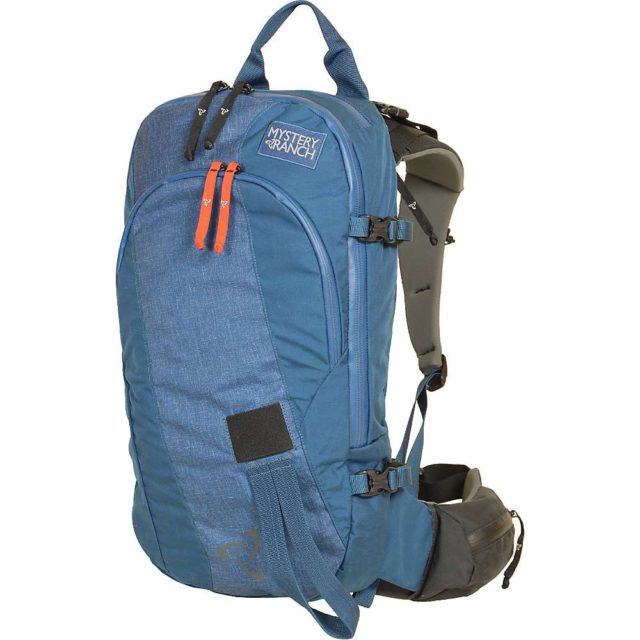
Mystery Ranch Saddle Peak Pack
Reviewer: 5’8” 155 lbs, Torso Length: 17”
Size Tested: S/M
Stated Weight: 1700 grams
Blister’s Measured Weight: 1638 g
Stated Volume: 21 Liters
Stated Features:
- 330D CORDURA® lite Plus fabric for lightweight durability and YKK® zippers
- Beefy 500D nylon, PU coated fabric on pack face to deflect sharp ski edges
- Options for both diagonal and A-frame ski carry
- Top compression strap for diagonal ski carry
- Compression-molded back panel and laminated stretch woven waist belt & yoke repel snow
- Streamlined avy pocket allows you to carry all of your safety gear in one easily accessible front pocket
- Main zippered compartment with urethane coated zipper for extra weather protection
- Body panel zip for easy, on-the-fly access when skis are attached
- Hydration reservoir compatible
- Telescoping yoke for custom torso fit
- Available in Women’s specific harnessing sizes XS and S/M
MSRP: $229
Test Locations: Lake Louise Ski Resort & Sunshine Village, AB; Revelstoke Mountain Resort, BC; Cameron Pass & Telluride Ski Resort, CO
Days Tested: ~15
Intro
Ski / snowboard packs have to balance a lot of things. They need to offer enough usable volume to hold the daily essentials, yet remain minimal enough so that you don’t notice them while, you know, actually skiing. And if you’re touring with the pack, you’ll also want to be able to easily access avalanche gear and carry skis / snowboards. This year, Mystery Ranch introduced the Saddle Peak, which is designed to meet the needs of skiers / snowboarders who spend time both in, and out of the resort. We’ve been very impressed by Mystery Ranch’s burly climbing and backpacking packs in the past, and now it’s time to take a look at their snowsport-specific Saddle Peak.
Here’s what Mystery Ranch says about the Saddle Peak:
“With its 21-liter capacity, the Saddle Peak is the ideal size for a well-provisioned ski tour. Featuring a streamlined avy pocket to contain and organize snow tools – you’re always ready for fast deployment of your essential safety gear. Offering multiple ski carry options, this pack melds all we’ve learned from years of face shots and head plants.”
Fit
Mystery Ranch offers the Saddle Peak in 3 sizes: XS, S/M, and M/L. A quick scan of their size chart led me to the S/M, which fits my 17” torso quite well.
One of the most notable features of the Saddle Peak is the pack’s sturdy frame sheet. The plastic sheet is easily adjustable to adapt to differences in torso length, and it did not take me long to dial in the fit.
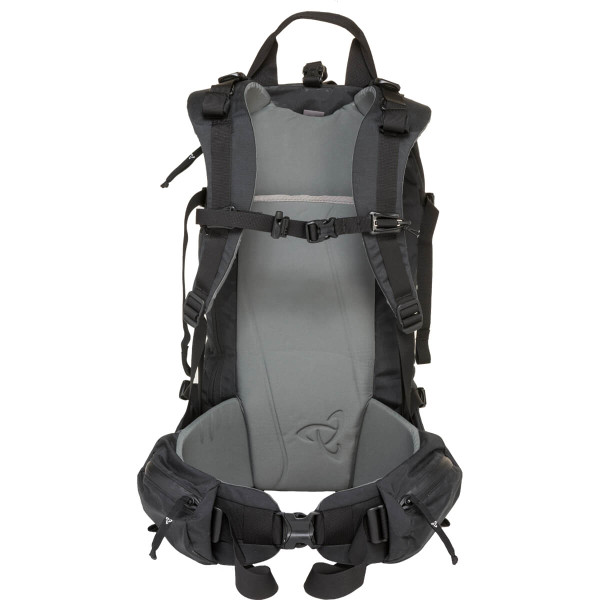
Once the frame was adjusted, I was left with a very snug, comfortable fit. Along with the supportive frame, the Saddle Peak’s multiple size options make it stand out from other snow packs that only come in one size or without any sort of suspension system.
Volume
The Saddle Peak’s fairly small stated volume of 21 liters made me a bit worried that it wouldn’t work for longer days of touring, and would instead be limited to short trips or days at the resort.
However, even without drastically altering my touring kit, I’ve been able to spend full days touring with the Saddle Peak. Below is the gear I most often carry with me in the Saddle Peak. Apart from the helmet, I can store everything inside the pack.
- Patagonia Micro Puff Hoody
- 1L Nalgene
- Olympus OM-D M5 Mirrorless Camera
- Hestra Leather Fall Line Mitts
- Goggles (all goggles I’ve used fit nicely in the goggle pocket)
- BCA B-1 EXT Shovel
- BCA Stealth 270 Probe
- Skins cut for the 180 cm Line Sick Day 114 or 182 cm Atomic Backland FR 109
- Accessories (ski straps, wallet, etc.)
- Minimal First Aid Kit
- Helmet (clipped on outside using the pack’s compression straps)
I think some people will find the Saddle Peak to be too small for touring, but it’s worked well for me. Plus, when not fully loaded, it still works very well for shorter tours or days spent riding lifts.
For comparison, the Saddle Peak feels like it holds a bit less than the Scott Backcountry Guide AP 30 (review coming soon), which includes the Alpride airbag system. However, the difference here isn’t as drastic as I figured it’d be.
Pockets
The Saddle Peak has one main compartment that takes up most of the pack’s volume. Access to the main compartment can be gained either through the standard body zipper, or through another zipper on the side. The side zipper is great for quick-access to the main compartment, and you can use it to get to your stuff when using the diagonal ski carry.
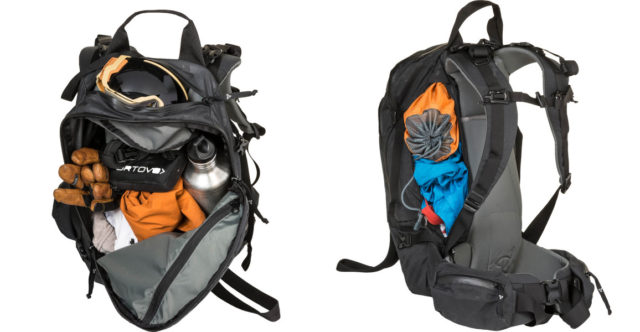
The Saddle Peak has an exterior, separate pocket with sleeves for avalanche gear that securely holds my probe, shovel, and skins, though the fit is a bit tight vertically when using a probe that is 18” folded up. However, it’s not so tight that I’m worried about it compromising response time in the event that I need quick access to my shovel / probe.
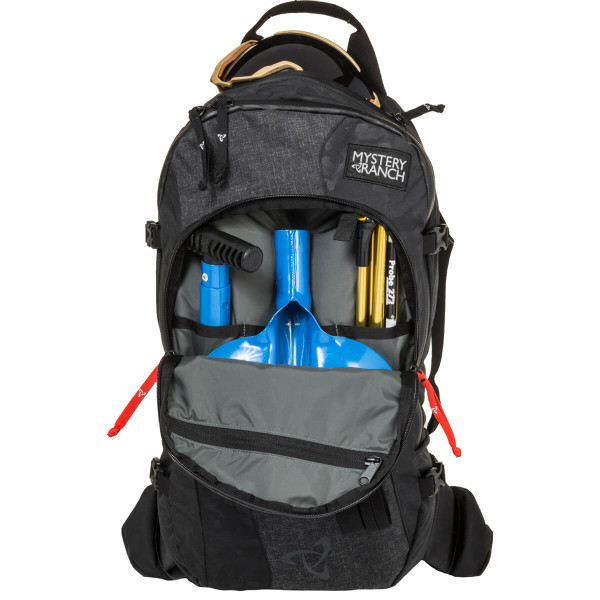
The Saddle Peak also has a zippered goggle pocket on the top of the pack, and internal zippered pockets in each compartment that are great for ski straps, bars, wallet, etc.
Finally, the pack also has fairly large zippered pockets on each side of the hip belt, and they are great for holding a slope meter, multi tool, granola bars, or any other small, quick-access items.
All pockets on the Saddle Peak are closed with large, reverse-coil zippers with long webbing pulls (the avy pocket has red zipper pulls so you can quickly identify them). The zippers on the hip belt pockets, main compartment, and avy gear pocket are all coated for water resistance. Despite the coating, I’ve found the zippers to slide very easily.
Features
The Saddle Peak is no minimalist skimo pack, which I’ve come to appreciate.
The Saddle Peak has two buckled compression straps on each side that can be used for A-frame ski carry, or to slim down the pack when it’s not full.
For diagonal ski carrying, the Saddle Peak has a giant, burly webbing loop on the front of the pack that slides snugly under a elastic band to stay out of the way when not in use. The pack has another buckled compression strap at the top of the pack to keep skis tight up top. The Saddle Peak’s diagonal ski carry loop is large enough to work with all the twin-tip skis I’ve used, though getting the splayed tails of a ski like the ON3P Kartel 108 does take a bit of work.
The buckles on the side compression straps are set up so that you can also run them across the front of the pack for carrying a snowboard. Mystery Ranch sells reinforced pads for the snowboard carry function that help protect the webbing straps from board edges.
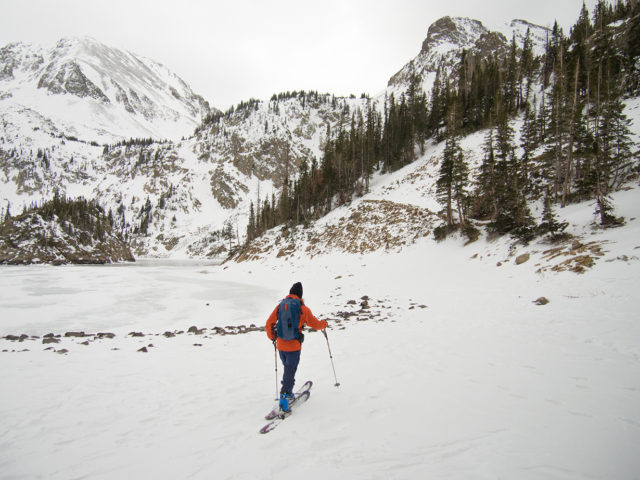
All the compression straps on the Saddle Peak include a velcro tab at the end so you can roll up the excess webbing to avoid getting wacked in the face by a stray strap while skiing.
The plastic hip belt buckles on the Saddle Peak are nice and large, and I haven’t had any issues using them with mittens. It’s also worth noting that while in Telluride, we had a few different reviewers of varying waist sizes all use the Saddle Peak, and everyone was able to tighten or loosen it to get a secure fit.
The chest strap’s buckle is a bit smaller than I’d like for a pack that I’m most often using with gloves / mitts, but I haven’t found it any more difficult to use compared to the chest strap buckles on any other packs I’ve used.
The Saddle Peak does not have a sleeve to hold a helmet, but attaching a helmet’s straps to the pack’s upper compression straps works just fine.
In Use
In short, the Saddle Peak performs very well as a ski pack. It provides a very snug, secure fit that doesn’t bother me all that much when jumping (read: flailing) around. At the same time, it carries pretty much everything I need for resort days or most backcountry outings.
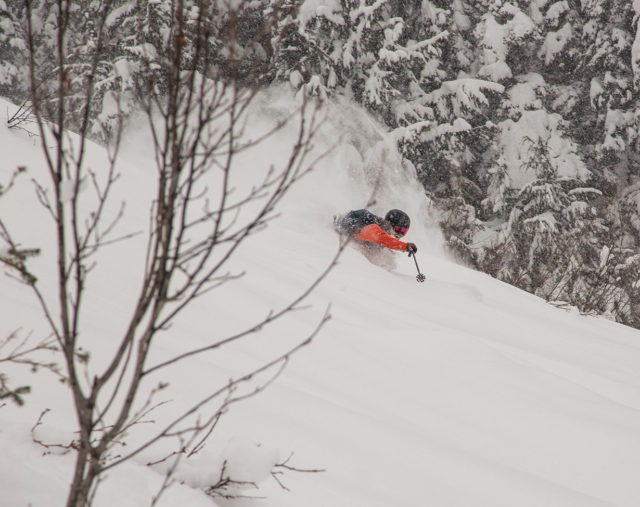
The Saddle Peak also handles heavy loads way better than any other pack I’ve used that also performs this well while skiing. This is all thanks to its sturdy frame sheet and hefty shoulder / hip straps, which are rare in a pack this small. I could comfortably load up skis on the pack and hike without having any shoulder pain (the Saddle Peak distributes weight to my hips very well). If you often end up strapping your skis to your pack for hikes, I think you’ll very much appreciate this aspect of the Saddle Peak.
Durability
After about 15 days in the Saddle Peak, I have zero durability issues to report. While that’s certainly not enough time to fully gauge a pack’s long-term durability, the burly materials / components on the Saddle Peak give me a lot of confidence in the pack’s durability.
It’s also worth noting that Mystery Ranch has a warranty that covers any sort of manufacturing defects, and they’ll repair non-warranty damage for a nominal fee.
Price
Though I’ve been very impressed by the Saddle Peak and think it performs significantly better than other similar packs I’ve used, it also comes in at a significantly higher price of $229.
Who’s It For?
If you’re looking for a pack that can handle heavy loads well, but don’t want a giant bag that feels super bulky while actually skiing / riding, the Saddle Peak is an excellent option. Its frame distributes loads far better than any other ~20L pack I’ve used, and even better than some 40-50L packs with aluminum stays like the old Black Diamond Anarchist 45.
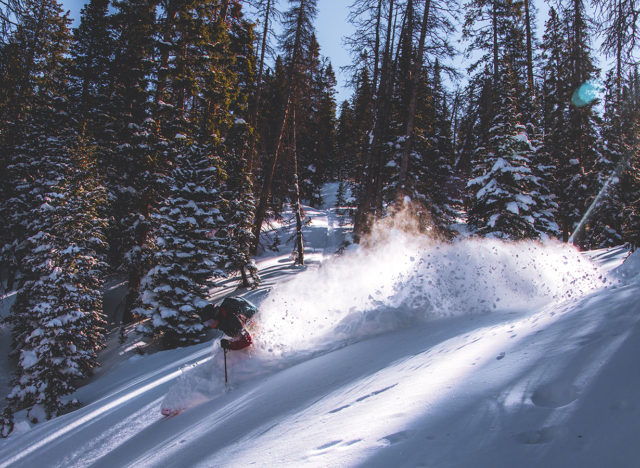
The Saddle Peak’s generous feature set and pocket layout also make it a good option for those that prefer organization options over one voluminous compartment.
With all that said, the Saddle Peak’s 21 liter volume will likely be too small for some people, and it’s definitely not very light at 1638 grams for the S/M size. So, weight-conscious backcountry users might be better off with lighter and / or larger packs.
Bottom Line
The Mystery Ranch Saddle Peak backpack does an excellent job of balancing the requirements of a 50/50 snow pack. I’ve been able to do plenty of day tours with it, yet it also feels very stable while skiing and isn’t that unwieldy on a chairlift. It has a bunch of useful features, and carries loads better than any other pack of this size that I’ve used. If you’re looking for a new inbounds pack and appreciate a sturdy frame, and / or pack fairly light in the backcountry and don’t need a ton of space, I think the Saddle Peak is a fantastic option.

Wholeheartedly agree with that review… I had the pleasure of using the pack (thank you Alpenglow Sports for ordering it for me!) both in bounds and out of bounds on a recent weekend in Tahoe. Plenty of space to carry what I needed, but I felt that the helmet carry while skinning was a bit haphazard — if the reviewer has a photo of how he managed to secure the helmet, I’d be keen to replicate it.
I’m also the proud owner of Mystery Ranch’s original Blackjack avalanche bag — I’ve used it extensively for hut to hut multi-day tours in the Alps and agree that their bags are pretty burly and mine have stood up to all the abuse I could throw at them.
Hi Chris,
I’ll upload a photo later, but my technique is to basically lay the helmet on the front of the pack (over the avy gear pocket) and then loop the upper compression straps of the pack through the opening in the helmet chin straps on either side. It is worth mentioning that I don’t use helmets with the ear pads / liners, so this might make a difference. But once the pack’s compression straps are through the helmet’s chin straps, the helmet is quite secure.
Hope that helps clear things up, and I’ll upload a photo soon.